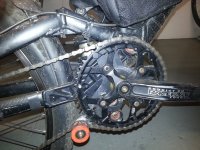Duc998
10 W
Hi guys,
I'm stuck and need some advise. I've got a 48t Shimano Deore Chainring Outer on my DH Comp. If I just off the pavement onto the road half the time
the chain comes off, Mostly towards the outer side of the chain. Even droping down the gears quickly will sometimes result in the chain coming off. Annoying
when commuting to work
Now I know I need a chainguide / tensioner but stuck to what will fit on a DH Comp 03 model with a 48t. Also could having a 48t "Outer" ring be the issue? I say
this as I notice some of the teeth a shorter then others. Its not the wear on the chainring but maybe by design from dropping to the middle / inner rings.
Can anyone recommend what to get?
Pic attached...

I'm stuck and need some advise. I've got a 48t Shimano Deore Chainring Outer on my DH Comp. If I just off the pavement onto the road half the time
the chain comes off, Mostly towards the outer side of the chain. Even droping down the gears quickly will sometimes result in the chain coming off. Annoying
when commuting to work
Now I know I need a chainguide / tensioner but stuck to what will fit on a DH Comp 03 model with a 48t. Also could having a 48t "Outer" ring be the issue? I say
this as I notice some of the teeth a shorter then others. Its not the wear on the chainring but maybe by design from dropping to the middle / inner rings.
Can anyone recommend what to get?
Pic attached...




